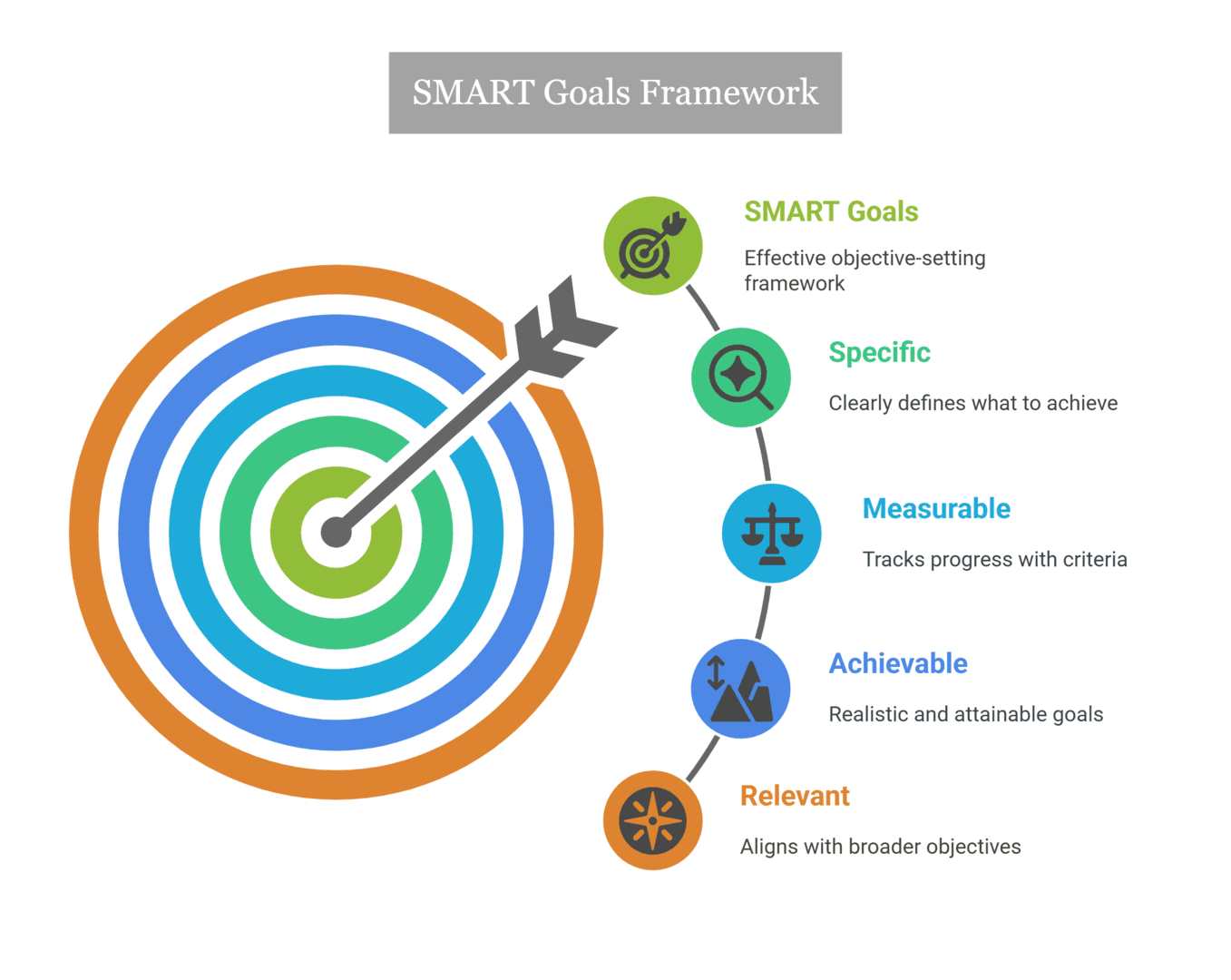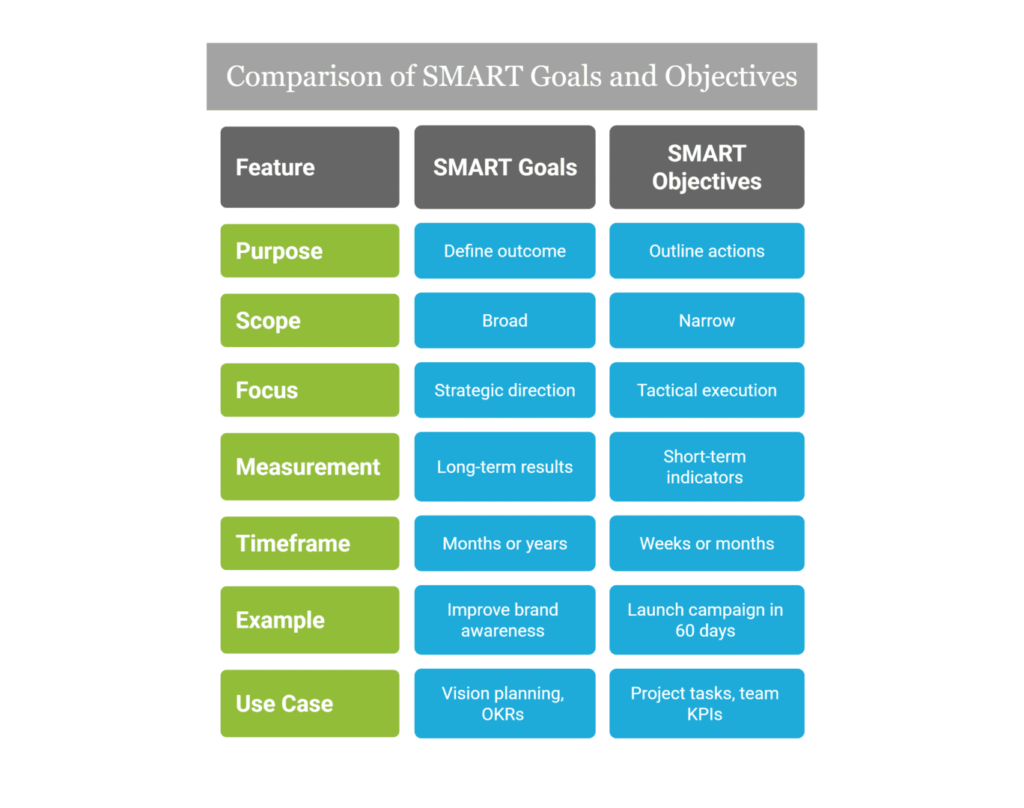Guide to Setting SMART Project Objectives and Goals
Table of Contents

- jaro Education
- 12, May 2024
- 10:29 am
Projects are the core of organizations, fueling growth, innovation, and operational excellence. Yet, without clear and attainable objectives, projects can easily fail to deliver the desired outcomes. This underscores the importance of setting SMART goals—an acronym for Specific, Measurable, Achievable, Relevant, and Time-bound.
This blog will look at the details of setting SMART project objectives and goals and offer practical ideas and perspectives to help you to improve your project management practices. Whether starting a small initiative or a large-scale enterprise project, mastering the art of setting SMART goals will help your project succeed.
What are SMART Goals?

SMART goals represent a framework for setting clear and manageable objectives within projects. The acronym “SMART” stands for Specific, Measurable, Achievable, Relevant, and Time-bound. This method encourages project managers and teams to design precise, traceable, attainable goals that are significant to the project’s achieving purpose, which are limited by time. Adhering to this approach turns each goal into a common target that provides a strong direction and facilitates progress monitoring.
Importance of Setting SMART Goals in Project Management
Setting SMART goals in project management is important because it transforms big goals into actionable steps. This results in several benefits.
- First, it ensures that every project team member has clarity about what needs to be achieved, thereby reducing the likelihood of misunderstandings and misdirection.
- Secondly, it facilitates measuring progress and success, allowing for timely adjustments if necessary. Furthermore, SMART goals support team members’ motivation by providing clear milestones for which to strive.
- Lastly, pinning down relevant and time-bound goals enhances resource allocation and time management, two critical factors in completing any project.
Components of SMART Goals
Here are the prime components of SMART goals.
1. Specific
The ‘Specific’ component of SMART goals dictates that objectives should be clearly defined and unambiguous. This involves asking the who, what, where, why, and which aspects of the goal to ensure a precise and focused aim is set. A specific objective answers what exactly is to be achieved, eliminating any generalities or broad statements that may lead to confusion.
2. Measurable
A goal must be measurable to track progress and know when it has been achieved. This involves identifying what evidence will demonstrate the goal’s completion and how success will be measured. Whether it’s a numerical target, completion of certain tasks, or an observable change in operations, measurable criteria aid in continuous assessment and motivation throughout the project lifecycle.
3. Achievable
For a goal to be achievable, it needs to be realistic and attainable within the project’s scope and resources. This means assessing the goal’s feasibility, considering the team’s capabilities, budget, and deadline. Setting achievable goals prevents setting the team up for failure from the start and ensures that targets push the team to progress without being demoralizing.
4. Relevant
Relevance ensures that each goal aligns with the broader objectives of project management and the organizational strategy. This criterion prompts the consideration of whether the goal matters to the project and if now is the right time for its pursuit. Relevant goals keep the project focused and ensure that every effort contributes towards the overarching aims, maximizing project impact and efficiency.
5. Time-bound
Being time-bound means specifying when the goal needs to be completed. This introduces a sense of urgency and helps prioritize resources and efforts. Setting a deadline prevents tasks from being deferred indefinitely and promotes a disciplined approach to project management. By having a clear timeline, teams can plan and adjust their work schedules accordingly, maintaining progress and momentum toward goal achievement.
Steps to Setting SMART Project Objectives
To make a SMART project, you need to follow a few steps as described below.
1. Identify specific project objectives
The initial step in setting SMART project objectives is to delineate specific goals that you want to accomplish. This requires a precise understanding of what success looks like for the project. Setting vague or overly broad goals can lead to confusion and a lack of focus. Instead, objectives should be clear and detailed, allowing everyone involved to understand exactly what is expected.
2. Determine key metrics for measuring success
After identifying specific project objectives, it is crucial to determine how success will be measured. This involves selecting key performance indicators (KPIs) that are quantifiable and directly related to the objectives. These metrics enable you to track progress, make adjustments as needed, and ultimately assess whether the project goals have been met. For example, if the objective is to enhance customer satisfaction, a key metric could be the Net Promoter Score (NPS) or customer satisfaction survey results.
3. Assess feasibility and relevance
Before finalizing your objectives, assess their feasibility and relevance to the organization’s overall strategic goals. This includes considering available resources, potential constraints, and how the aim of the project aligns with the company’s broader objectives. Objectives should be ambitious yet achievable, considering your team and organization’s current capabilities and limitations. Moreover, ensuring the objectives are relevant helps maintain focus on activities that provide the most value.
4. Set a realistic timeline
Establishing a realistic timeline for achieving your project objectives is crucial. This involves breaking down the objectives into smaller milestones with their deadlines. A well-structured timeline creates a sense of urgency and provides a clear roadmap for the project team. It also facilitates regular monitoring and evaluation of progress, allowing timely adjustments to stay on track.
Applying SMART Objectives in Project Management
Let us have a deep knowledge through the famous case study.
Case Study: Grocery LLC’s E-Commerce Mobile Initiative History:
Grocery LLC is a regional supermarket with a presence of 50 stores across five states. The company faced challenges from long checkout lines and an uninspiring mobile shopping experience. Part of its strategies to confront these challenges included initiating a project aimed at enhancing the company’s mobile commerce capabilities.
SMART Objectives Applied: Specific makeover of the website for mobile purposes to be user-friendly and responsive for customers ordering through mobiles. Measurable target to increase online sales by at least 25% and achieve customer satisfaction improvement by 20% three months after the launch.
Achievable: Make use of existing IT and marketing teams to conceptualize and put into practice the new mobile solutions within a two-month window. Relevance is given to this project since it makes the company’s effort towards improving customer experience to widen its market share in the digital shopping space. Time-bound:
Duplicate of the redesign of the mobile website, with the building of a completely new mobile application tied within, will be completed in two months. The following three months will be allotted to achieve the sales and satisfaction metrics.
By adhering to these SMART objectives, Grocery LLC had successfully launched the new mobile website and application on schedule. Following the metrics, online sales jumped 28%, as well as customer satisfaction, which was rated at 22%, both exceeding the original target.
What is SMART Analysis?
SMART analysis involves evaluating objectives and strategies against SMART project criteria to confirm that they are soundly structured as well as achievable. The analysis identifies gaps and helps to align strategies with goals and optimize performance.
How You Can Integrate SMART Analysis into Your Business Strategies
- Begin With Your Business Vision and Mission
Before anything else, be clear regarding your overall direction. Your SMART goals should support your long-term mission and short-term objectives for your business.
- Break Down Strategic Objectives into SMART Goals
Take each high-level strategy and apply the SMART framework.
| Specific | Measurable | Achievable | Relevant | Time-bound |
| Define what exactly needs to be accomplished. Increase online presence Launch and actively maintain a company LinkedIn page targeting B2B clients. | Attach metrics to track success. Gain 1,000 LinkedIn followers within 3 months. | Ensure it's within reach based on resources, time, and capabilities. With one dedicated social media coordinator, post thrice a week." | Tie the goal directly to your strategic priorities. Improve digital presence to attract partnerships and improve brand credibility. | Set a deadline or timeline. For instance, while launching the LinkedIn page, keep the TAT by 15th May and reach KPIs by 15th August |
- Use SMART Goals Across All Departments
Each team (marketing, operations, sales, HR, etc.) should set its own SMART goals that align with the larger strategy.
- Monitor, Measure & Adjust
Establish regular review cycles (monthly or quarterly) to:
- Track progress with clear KPIs
- Identify what’s working or failing
- Adjust goals or timelines as needed
- Integrate into Performance Reviews & Team Metrics
Link employee and team evaluations to SMART-based outcomes. It boosts clarity, accountability, and motivation.
Definition of SMART Management
SMART management involves the use of SMART principles in the management of projects, people, and organizational strategies. SMART management involves setting specific, measurable, achievable goals aligned with higher-level objectives and managing the timely implementation of these goals.
Benefits of Using SMART Goals in Projects
Because of its numerous benefits, the SMART goals methodology has become a cornerstone of project management and goal setting. Implementing this approach can significantly impact productivity, project success, and team morale, as discussed here.
- Increased clarity and focus
By defining specific and relevant goals, project teams gain clarity on what needs to be accomplished. This clarity translates into a sharper focus on tasks, minimizing distractions, and directing efforts where they are most needed. When each team member understands the project objectives precisely, it streamlines the process and facilitates more effective collaboration.
- Enhanced motivation and engagement
Motivation and engagement are byproducts of setting achievable and time-bound goals. When team members view objectives as attainable within a set timeframe, it fosters a sense of urgency and purpose, boosting overall morale. This increased engagement results in a more dedicated workforce, driving the project forward with collective energy and enthusiasm.
- Improved project performance and outcomes
Utilizing measurable outcomes within the SMART framework facilitates ongoing monitoring and adjustment of strategies, ensuring project performance is continually optimized. This approach enables teams to stay on track, meet deadlines, and achieve desired results, improving project outcomes. The precision and structure provided by SMART goals eliminate ambiguity, making it easier to gauge success and implement corrective measures when necessary.
Common Pitfalls to Avoid When Setting SMART Goals
While the benefits of SMART goals are clear, common mistakes can undermine their effectiveness. Awareness of these pitfalls is crucial for project managers and teams aiming to leverage the SMART methodology fully.
- Vagueness: The foundation of SMART goals lies in their specificity. When goals lack clarity and precision, individuals may be adrift and unsure how to proceed. Ensure your goals are clearly defined to combat this, leaving no room for ambiguity. For instance, rather than stating a goal to “improve communication skills”, specify undertaking a public speaking course and delivering a presentation to your team by a deadline.
- Unrealistic Expectations: Ambitious goals can motivate, but when they veer into fantasy, they can lead to frustration. It’s vital to set targets that stretch your abilities without overreaching. This requires a realistic assessment of your capabilities, resources, and the context in which you operate. For example, instead of aiming to “become a millionaire by the end of the month”, set a goal to increase your income by a manageable percentage through feasible means like pursuing a promotion or engaging in a side hustle.
- Ignoring Relevance: Goals that lack personal significance are unlikely to inspire sustained effort and commitment. It’s important to align your goals with your values, aspirations, and overarching vision for your life. This ensures that your efforts are directed towards meaningful pursuits that resonate with you on a deeper level. For instance, rather than pursuing a goal to “learn a new language” simply because it’s popular, focus on acquiring skills that directly contribute to your career advancement or personal growth.
- Neglecting Action Steps: A well-defined goal is only the first step; progress is unlikely without a clear plan of action. It’s crucial to break down your goals into manageable tasks and identify the steps required to achieve them. This approach provides a roadmap for implementation and helps to bridge the gap between intention and execution. For example, if your goal is to “lose 10 pounds by the end of the month”, outline specific dietary and exercise routines that will contribute to your objective.
- Forgetting to Monitor Progress: Goals are dynamic entities that require regular monitoring and adjustment. Without ongoing evaluation, losing sight of your progress and veering off course is easy. Establish checkpoints to assess your progress, celebrate milestones, and identify areas for improvement. This allows you to stay on track and make necessary course corrections as you work towards your goals.
- Giving Up or Losing Motivation: Challenges and setbacks are inevitable in the journey to achieving the goal. However, succumbing to defeat or losing motivation can derail your progress. Cultivate resilience and perseverance to navigate obstacles and setbacks with determination and resolve. Seek support from mentors, peers, or coaches to stay motivated and focused on your goals, even in adversity.
Implementing and Monitoring SMART Goals
Implementing and monitoring SMART goals is a crucial phase in the project management process. Setting objectives is not enough; a structured approach to tracking progress and making necessary adjustments to stay on course is also necessary.
- Clear Communication and Alignment
Ensure team members understand objectives and their roles. Regular updates and meetings facilitate insights, address obstacles, and maintain focus. Project management tools aid communication and visualizing progress.
- Regular Progress Tracking and Adjustments
Establish KPIs aligned with SMART goals. Monitor progress regularly to identify lagging areas and make necessary adjustments. Flexibility is key to adapting strategies in response to challenges or scope changes.
- Celebrating Achievements and Learning from Setbacks
Acknowledgement of milestones to boost morale and reinforce project value. View setbacks as learning opportunities and analyze them to improve future management. Resilience and adaptability are crucial for project success.
SMART Goals vs. SMART Objectives: Clarifying the Distinction
When considering SMART goals and SMART objectives, it’s essential to discern their unique roles despite their apparent similarities. While both serve as guides for project achievement, they operate at different levels and offer distinct perspectives on the journey toward project completion.
What Are SMART Goals?
A SMART goal is an aspirational objective that describes what you wish to achieve. It is a compass that gives you direction and motivation, whereas success itself is the end vision.
The characteristics of SMART goals:
- They have a wide scope, yet they remain SMART
- The goals are linked with the mission or the long-term vision
- They generally ask, “What do we want to accomplish?”
- They are like the destination instead of the road map.
What Are SMART Objectives?
SMART objectives break down SMART goals into smaller, actionable, and more focused steps. Often, they serve to define how to achieve the larger goal.
Characteristics of SMART Objectives:
- Specific and task-focused
- Intended to achieve the goal
- They denote milestones or measurable steps
- Usually answer the question: “How will we get there?”

Enroll With Jaro Education
Jaro Education isn’t just another online education platform; we’re your dedicated career transformation partner. With over 350,000 professionals trained and strong partnerships with leading academies, we’re redefining career advancement.
Why Jaro Education?
We offer personalized career counseling through Jaro Connect and Career Services, including:
- Resume & LinkedIn Optimization
- Mock Interviews and Career Counseling
- Job Recommendations from over 500 hiring partners
- Placement support across roles and industries
With Jaro, you don’t just learn; you become job-ready.
Is Jaro Education Right for You?
If your goals include strategic career growth, learning from world-class universities, hands-on support for your next job, and earning more while working smarter, then Jaro Education is the right choice.
How to Enroll via Jaro Education: Your Partner in Career Transformation
Visit www.jaroeducation.com, browse programs, speak to an advisor, and enroll online in just a few clicks!
Conclusion
Setting SMART goals is only the first step in achieving project success. Implementing and monitoring those goals requires clear communication, frequent progress tracking, and constant cooperation in team efforts. Celebrating successes and learning from setbacks enriches the experience, fostering a culture of continuous improvement and resilience. Following these principles allows project managers and their teams to increase productivity and ensure project success significantly. Start your journey towards project excellence with the Online MBA Programme – Manipal University Jaipur, as this course will help you transition into a future leader with expertise.
Frequently Asked Questions
SMART stands for:
- Specific – What exactly do you want to accomplish?
- Measurable – How will you track progress or know when it’s achieved?
- Achievable – Is the goal realistic with current resources?
- Relevant – Does it align with your broader business/project objectives?
- Time-bound – When should it be completed?
SMART objectives help by:
- Providing clear direction and focus
- Enabling performance tracking and accountability
- Improving communication among stakeholders
- Reducing scope creep and ambiguity
- Ensuring alignment with project goals and business strategy
- SMART Goals: Broad outcomes or long-term ambitions
- SMART Objectives: Specific, short-term steps that help achieve the broader goals
- Think of goals as the destination and objectives as the roadmap.
- Objective: “Redesign the company website homepage to improve user engagement by 25% within 60 days.”
This is SMART because:
- Specific: Redesign the homepage
- Measurable: 25% increase in engagement
- Achievable: Based on available design and dev teams
- Relevant: Tied to user experience and marketing goals
- Time-bound: 60 days
- Project Managers
- Team Leads
- Stakeholders
- Clients or End-Users (when relevant)
- Collaborative input ensures realistic and meaningful objectives.









